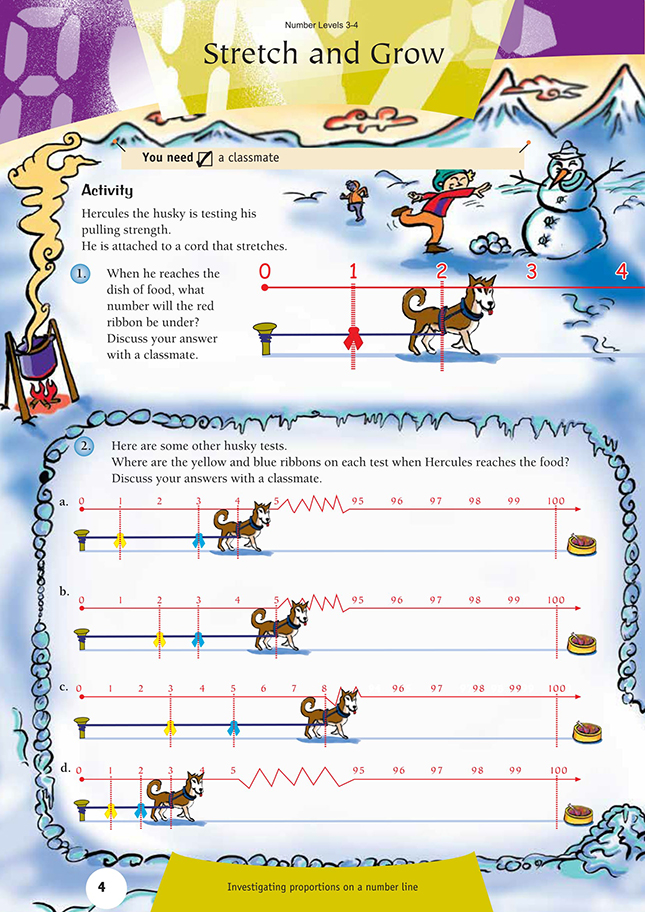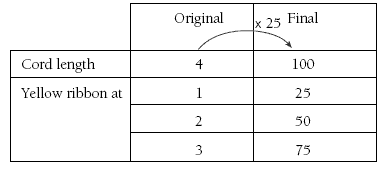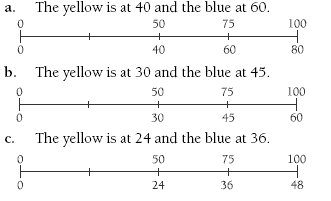This is a level 4 number activity from the Figure It Out series. It relates to Stage 7 of the Number Framework.
A PDF of the student activity is included.
Click on the image to enlarge it. Click again to close. Download PDF (587 KB)
investigate proportions on a double number line
FIO, Level 3-4, Number, Book 1, Stretch and Grow, pages 4-5
A classmate
The students need to have the opportunity to explore the situations in this activity on their own and to discuss their answers. Then discuss with them the strategies that they could use to solve the problems in the activity.
Two strategies that could be used here are:
1. Expressing quantities as fractions and then finding that fraction of the whole amount or using equivalent fractions.
In question 1, the ribbon is initially at 1 and Hercules is at 2. If the ribbon starts halfway along the cord, it is still halfway along the cord when the cord is stretched. When the cord stretches out to 10, the ribbon will be at half of 10, which is 5.
Alternatively, we could say 1/2 = ?/10 and solve the problem using equivalent fractions. Each two-ribbon question has two parts to it. For example, for 2a, the yellow ribbon is at 1 and Hercules is at 4. The yellow ribbon is 1/4 of the way along the cord. One-quarter of 100 is 25, so the yellow ribbon ends up at 25. The blue ribbon is at 3, and Hercules is still at 4. The blue ribbon is 3/4 of the way along the cord. Three-quarters of 100 is 75, so the blue ribbon ends up at 75. In the two-ribbon questions, make sure that the students are comparing the position of each
ribbon to the position of Hercules and not to the position of the other ribbon.
2. Using a double number line or a table.
A double number line can be used to represent these problems. (Double number lines have been shown in the Answers.) For example, for question 2a:
What do you multiply 4 by to get 100? (25) You then multiply the 1 by 25 to find the
position of the yellow ribbon and the 3 by 25 to find the position of the blue ribbon.
A table can also be constructed to represent the situations, for example, for question 2a:
Working with double number lines and tables like these is a good basis for working with ratios in level 5 of the curriculum.
Questions 2c and d are more difficult because they involve finding eighths and thirds of 100. One-eighth of 100 is 121/2, and 1/3 of 100 is 331/3. Again, the students will find using double lines (as shown in the Answers) is a helpful strategy
The students could also find these answers using the following method:
Question 3 involves the reverse process, where the rope is at its full extent and the students have to work out what the equivalent fractions are. For example, for 3a, 50/100 = 1/2. Half of 80 is 40, so the yellow ribbon will be at 40. Again, double number lines for question 3 are shown in the Answers.
Answers to Activity
1. At the 5 marker. When Hercules is on 2, the ribbon is on 1, halfway between him and the start. So when he is on 10, the marker will be halfway, on 5.
2. a. The yellow ribbon is at 25, and the blue is at 75. In the illustration, the yellow is at 1, and the dog is at 4, so the yellow is 1/4 of the way along the cord. One-quarter of 100 is 25. The blue ribbon is at 3, and the dog is at 4. Three-quarters of 100 is 75.
b. The yellow is at 40 (2/5 of 100 = 40) and the blue at 60 (3/5 of 100 = 60).
c. The yellow is at 371/2 (3/8 of 100 = 371/2) and the blue at 621/2 (5/8 of 100 = 621/2).
d. The yellow is at 331/3 (1/3 of 100 = 331/3) and the blue at 662/3 (2/3 of 100 = 662/3).
3.








